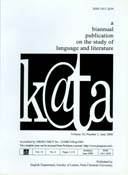Tyranny of Conventions: A Comparative Study of Blake's Visions and Hardy's Tess
Abstract
William Blake's Visions of the Daughters of Albion (1793) and Thomas Hardy's Tess of the d'Urbervilles (1891) have much in common. Both deal with female sexuality and question the society's sexual and religious mores by portraying a revolutionary woman who fights to gain her autonomy and self-assertion. However, as subjects/products of the dominant ideologies and conventions of their time, Blake and Hardy seem to empower the very conventions they try to reject in portraying heroines tyrannically destroyed by the long-held conventions that condemn an unmarried woman's sexual experience. These heroines' self-assertion/rebellion fails tragically. In this paper we argue that, comparatively, the ambivalent treatment of the notion of independent woman is the most significant common feature in Blake's poem and Hardy's novel. On the one hand, both Blake and Hardy introduce a woman with a new sexual identity and, on the other hand, they deprive their heroines of voice and independence.
Downloads
References
Bonaparte, F. (1999). The Deadly Misreading of Mythic Texts: Thomas Hardy's Tess of the d'Urbervilles. International Journal of the Classical Tradition, 5(3), 415-431. Retrieved from http://booksc.org.
Bloom, H., & Lionel, T. (1973). Romantic Poetry and Prose. New York: Oxford University Press.
Bloom, H. (2008). William Blake. New York: Bloom's Literary Criticism.
Bordin, R. (1993). Alice Freeman Palmer: The Evolution of a New Woman. Michigan: University of Michigan Press.
Cott, N. F. (1987). The Grounding of Modern Feminism. New Haven: Yale University Press.
Dever, C. (2005). Everywhere and Nowhere: Sexuality in Victorian Fiction. In Francis O'Gorman (Ed.), A Concise Companion to Victorian Novel (pp. 156-179). Oxford: Blackwell Publishing.
Farrell, M. (2007). Revolution and Revelation: William Blake and the Moral Law. Postgraduate English, 15(1), 1-21. Retrieved from http://www.dur.ac.uk/postgraduate.english.
Ferber, M. (1999). A Dictionary of Literary Symbols. Cambridge: Cambridge University Press.
Fox, S. (1977). The Female as Metaphor in William Blake's Poetry. Critical Inquiry, 3(3), 1977, pp. 507-519. Retrieved from http://www.Jstor.org/stable/1342937.
Gallant, C. (1978). Blake and the Assimilation of Chaos. Princeton, New Jersey: Princeton University Press.
Hardy, T. (2000). Tess of the d'Urbervilles. (M. Irwin, Ed.). Hertfordshire: Wordsworth Classics.
Heffernan, J. A. (1991). Blake's Oothoon: The Dilemmas of Marginality. Studies in Romanticism, 30(1), 3-18. Retrieved from http://www.Jstor.org/stable/25600877.
Hilton, N. (2003). Blake's Early Works. In Morris Eaves, (Ed.), The Cambridge Companion to William Blake (pp. 191-209). Cambridge: Cambridge University Press.
James, H. (1995). Daisy Miller. New York: Dover Publication, Inc.
Lacey, N. (2007). From Moll Flanders to Tess of the d'Urbervilles: Women, Autonomy and Criminal Responsibility in Eighteenth and Nineteenth Century England. Law, Society and Economy Working Papers, 1-31. Retrieved from http://www.lse.ac.uk/collections/law.
Mellor, A. (1982). Blake's Portrayal of Women. Blake: An Illustrated Quarterly, 16(3), 148-155.
Miller, A. $ Adams, J. E (Eds.). (1996). Sexualities in Victorian Britain. Bloomington: Indiana University Press.
Munteanu, A. (2006). Visionary and Artistic Transformation in Blake's Visions of the Daughters of Albion. Journal of European Studies, 36(61), 61-83. Retrieved from http://jes.sagepub.com/content/36/1/61.
Ramel, A. (2008). Tess's Silent Cry: the Vocal Object in Tess of the d'Urbervilles. English Text Constructin, 1(1), 113-124. Retrieved from http://bibliothek.univie.ac.at/english.
Rodden, J. (2011). Of “Natar†and God: a Look at Pagan Joan and Reverend James Clare. English Studies, 92(3), 289-308. Retrieved from http://booksc.org.
Shires, L. M. (1999). The Radical Aesthetics of Tess of the d'Urbervilles. In Dale Kramer, (Ed.), The Cambridge Companion to Thomas Hardy (pp. 145-163). Cambridge: Cambridge University Press.
Stubbs, P. (1979). Women and Fiction: Feminism and the Novel 1880-1920. London: Methuen.
Swearingen, J. E. (1992). The Enigma of Identity in Blake's Visions of the Daughters of Albion. The Journal of English and Germantic Philology, 91(2), 203-215. Retrieved from http://www. Jstor.org/stable/27710643.
Tanner, T. (1968). Colour and Movement in Hardy's Tess of the d'Urbervilles. Critical Quarterly, 10(3), 219-239. Retrieved from http://booksc.org.
Vogler, T. (1987). “In vain the Eloquent Tongueâ€: An Un-Reading of VISIONS of the Daughters of Albion, in D. Miller, M. Bracher & D. Ault (Eds.), Critical Paths: Blake and the Argument of Method (pp. 271–309). Durham: Duke University Press.
Williams, R. (1964). Thomas Hardy. Critical Quarterly, 6(4), 341-351. Retrieved from http://booksc.org.

This work is licensed under a Creative Commons Attribution 4.0 International License.
![]() This work is licensed under a Creative Commons Attribution License
This work is licensed under a Creative Commons Attribution License




.png)
.png)

.png)












